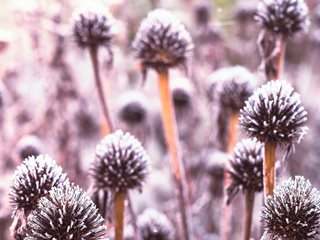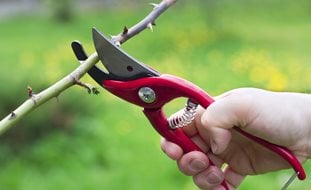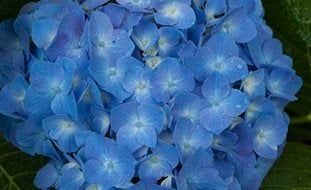A Gardener's Guide to Deadheading
Learn why, how and when to deadhead your garden plants Published 9/29/2022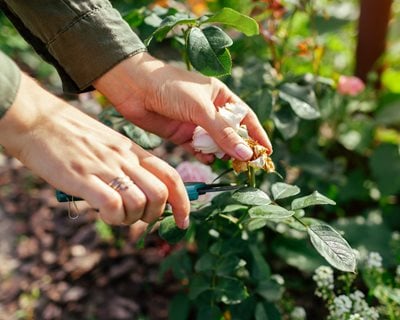
Photo by: Mariia Boiko / Shutterstock.
Most gardeners have heard the term “deadheading” when it comes to plants. But what does it mean and why is it important?
WHAT IS DEADHEADING?
Deadheading is the process of removing flowers that have finished blooming. In addition to improving the overall appearance, it allows plants to put more energy into producing more flowers, and it's the best way to control plants that self-seed. If plants aren’t deadheaded, they go on to produce seed. For annuals and perennials, seed production signals that the life cycle is complete and the plants will stop flowering or die.
HOW DO YOU DEADHEAD FLOWERS?
There are different ways to deadhead, with annual and perennial plants responding best to different methods. Here are the most common methods:
Pinching: For plants with soft fleshy stems such as petunias, coleus, basil, marigold, and pansies, pinch the stem at the base of the flower using your thumb and forefinger. Pinching will coax plants to become more bushy, resulting in more leaves and blooms.
Snipping: For plants with stiff or woody stems such as bee balm, coneflower, salvia, roses, and hydrangeas, use sharp hand pruners, clippers, or scissors to snip off flowers.
Shearing: Some plants such as sweet alyssum, tickseed, hardy geranium, and catmint will respond better to shearing the entire plant. Wait until the majority of flowers have bloomed, then cut plants back by a third to half of their size. Hardy geraniums and catmint can be cut back almost to ground level.
No matter which method is used, make sure to remove the entire flower, not just the petals, as the seeds are contained in the center.
WHERE TO DEADHEAD
The structure of a plant will determine where to remove spent flowers.
Single stems: For plants that produce flowers on single stems such as dahlia, pincushion flower, and zinnia, remove the flower back to the base of the stem, as close as possible to where it meets the leaves.
Multi-stems: For multi-stemmed flowers such as ageratum, cosmos, daisies, and sunflowers, cut off individual faded flowers. Take care not to cut off or damage adjacent flower buds. You can also wait until all of the flowers on a stem are finished blooming and cut them off all at once.
Small flowers: For plants with clusters of tiny flowers such as sweet alyssum and candytuft, lightly shear the entire plant to encourage rebloom.
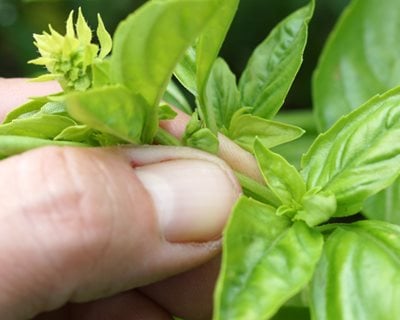
Basil will continue to produce new healthy leaves when flowers are regularly pinched. Flower production can trigger changes causing leaves to become bitter tasting. Photo by: Nancy J. Ondra / Shutterstock.
TYPES OF PLANTS TO DEADHEAD
Annuals benefit from regular deadheading to prolong flowering. This can extend the blooming season into fall. Pinch or snip off spent flowers, taking care not to remove adjacent buds. For small-flowered annuals such as sweet alyssum, wait until most of the flowers fade before shearing. Fertilize regularly to encourage rebloom. Annuals such as Calibrachoa and some types of petunias are self-cleaning, so they do not need to be deadheaded.
Perennials that will rebloom with deadheading include astrantia, black-eyed Susan, coneflower, lupine, penstemon, phlox, salvia, Shasta daisy, and veronica.
Shrubs that will produce more flowers with deadheading include butterfly bush (Buddleia), hydrangea, rose, and spirea.
Once-per-season bloomers such as iris, lilac, lily, peony, and tulip won’t generate new flowers when deadheaded, but will still benefit from the removal of spent flowers. This will put more energy into the plant or bulb, resulting in more vigorous growth and blooms the following year. The spent flowers of once-per-season bloomers such as astilbe and ornamental grasses can be left for the attractive seed heads.
Note: These are not exhaustive lists of what plants to deadhead. Check the specifics for your particular plants.
HOW TO DEADHEAD THESE COMMON PLANTS
Here are tips for deadheading these commonly grown plants:
Coneflower: Regular deadheading of coneflower (Echinacea) will extend bloom time. When deadheading, cut back to just above the first set of leaves. In late summer or early fall, cease deadheading and leave seed heads to provide food for songbirds and other wildlife. Learn more about growing coneflower.
Dahlia: Dahlias can bloom until frost with regular deadheading. Remove the spent flower heads back to just above the first intersecting branch, taking care not to remove side buds. New flower buds are rounded, while spent flowers are triangular or cone shaped. Learn more about growing dahlias.
Shasta Daisy: Shasta daisies will continue to produce more flowers if regularly deadheaded. Cut spent flowers back to the second set of leaves, or for a tidier look, cut the flowering stalk to the ground. Learn more about growing Shasta daisies.
Dianthus: Remove older flowers as soon as they fade, pruning back to the first set of leaves. Learn more about growing dianthus.
Geranium: So called annual geraniums (Pelargonium) are some of the most popular bedding plants. To improve flowering, snap off the flower stem at the base with your thumb and forefinger. Any part of the stalk that is left on the plant will continue to grow, taking energy away from the plant and new bud production. Learn more about growing annual geraniums.
Hydrangea: Cut back the stem of each spent flower to just above the first set of leaves. Flowers produced late in the growing season can be left for winter interest.
- For smooth and panicle hydrangeas which bloom on new wood, the best time to remove old flowers is in early spring before new growth emerges.
- Bigleaf, mountain, and oakleaf hydrangeas, which bloom on old wood, can be deadheaded as the flowers fade. Take care not to remove the buds that form starting in late summer for next year’s flowers.
- Reblooming varieties can be deadheaded in early spring before new growth emerges and again in summer, no later than mid-August when new buds are forming for next year’s flowers.
Learn more about growing hydrangeas.
Lavender: The flowers and leaves of this popular herb are harvested for a wide array of uses. Most lavender varieties produce two or more flushes of blooms in a growing season. Cut off fresh or faded flowers at the base of the stems. Learn more about growing lavender.
Peony: Cutting off spent flowers will not result in rebloom that season, but it does help divert energy back into the plant for lusher growth. Trim back old flowers to just above the first set of leaves. Learn more about growing peonies.
Petunia: Pinch off spent blooms between the thumb and forefinger. If plants become leggy, cut back by up to half their size in mid-summer to stimulate new growth and flowers. Some varieties are self-cleaning and need no deadheading. Learn more about deadheading petunias.
Rose: Roses can be one-time, repeat or continuous bloomers. Know which kind you have before pruning or deadheading. To remove spent flowers, cut the stem back to the first set of 5 leaves at a 45-degree angle away from the bud eye. Leave spent flowers if you want plants to develop hips for winter interest or culinary use. Learn more about growing roses.
WHEN NOT TO DEADHEAD
Spent flowers on some plants can be left to produce ornamental seed heads, fruit, or hips that provide food for birds and other wildlife in winter. These include:
- Bee balm (Monarda)
- Black-eyed Susan (Rudbeckia
- Coneflower (Echinacea)
- Gayfeather (Liatris)
- Globe thistle (Echinops)
- Stonecrop (Sedum)
- Culver's root (Veronicastrum)
- Roses
- Clematis
- Love-in-the-mist (Nigella)
- Other plants that produce autumn berries or fruit
Self-cleaning flowering plants such as angelonia, impatiens, calibrachoa, vinca, and some varieties of petunias need no deadheading.
Note: Again, these are not exhaustive lists; check the specifics for your particular plants.
FREQUENTLY ASKED QUESTIONS
When should you deadhead?
Cut off old flowers when petals begin to drop off and continue to remove spent flowers as they occur. Cease deadheading when the weather turns cooler if you want plants to form seeds for collecting or self-sowing. Some plants such as hydrangeas and roses have more specific deadheading needs.
Does deadheading produce more flowers?
Removing old flowers diverts energy away from seed production and encourages plants to produce more blooms.
What's the difference between deadheading and pruning?
Deadheading is the process of removing spent flowers. Pruning involves the removal of any part of the plant for the purpose of thinning, shaping, resizing, reinvigoration, or removing dead or diseased parts.
Should all flowers be deadheaded?
Most annual flowers benefit from regular deadheading. Some perennials and shrubs can be encouraged to rebloom with deadheading. Other plants only bloom once per season, so they will not produce new flowers even if deadheaded.
ADDITIONAL TIPS
- Make sure pruning tools are clean and disinfected to prevent the spread of disease.
- To make the chore of deadheading less daunting, take a few minutes here and there to deadhead plants rather than trying to do it all at once. Some gardeners find the process to be relaxing. Walk around leisurely with a cup of coffee or tea and snip your plants while enjoying your garden.
- Combine deadheading with a regular fertilizing regimen to get the most out of your annual flowering plants. Fertilize other plants according to individual needs to encourage more blooms.
- Dispose of spent flowers in the compost bin, trash, or yard recycling rather than leaving them around the plants to help prevent the spread of disease.
